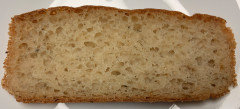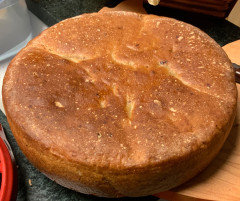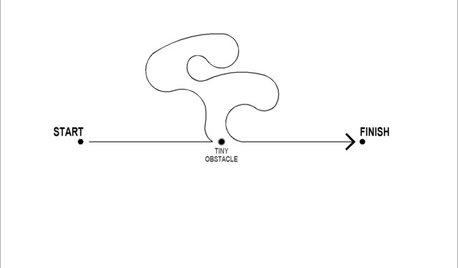Fun with Flour #2
Continuation of Fun with Flour #1 (and cousin to Fun with Sourdough):
https://www.gardenweb.com/discussions/5899338/fun-with-flour#n=186
I started Fun with Flour while testing what I can do with my new flour, and Fun with Sourdough about baking with the new flour and wild yeast. but these threads are for everybody! Please post your own flour creations! Or even just flour dreams. I love flour.
DANGER CAKE!!!!!!!
I love cake. Just cake. I mean, frostings and fillings are okay, but I tend to eat the cake first, and then, if I want "dessert" I'll eat the goop. It's not that I dislike frosting, I just don't really want it in the same mouthful as cake. Moreover, I'm not a big fan of whipped cream and hate it when cream makes the cake soggy. And pastry cream (custard), which is delicious, deserves paté au choux (eclair, profiterole, et al.) or puff or tart. I don't think either the pastry cream or the cake enhance the other. OTOH, see the exception below.
It took all my willpower not to cut the cake at bedtime, when I depanned and covered it. I settled for scraping crumbs from the pan. It took great force of adultness to have a properly nutritious breakfast, ignoring the siren call of cake. I did it! And didn't even realize when I got up to put my dish in the sink rather than lingering. ... Until I realized I was alone with the cake and could now have a piece!
The object of affection, er., obsession, is an orange chiffon cake. Nothing special. I wanted to see how my Organic Unbleached Artisan Baker's Craft flour from General Milling (GM AC) would do in cake, and while I was at it, I figured why not make an egg rising cake where the weight of the flour would really show. I did the dip/level volume measure. No sifting. Just followed the recipe as written. Well, except that I only had two oranges and needed the juice of three. I just filled out my measuring cup with Simply Orange (OJ), and I didn't measure the zest, just used all I had.
Mind you, this ain't my first rodeo. I don't bake cakes often, because, if you hadn't noticed, I love cake. But I've made countless chiffon cakes starting in childhood. Orange is my favorite. :)
I didn't want to use one of my grandmother's plates for the cake, and realized that my mother's plate had too much shape to it after I put the cake on it (my plates have rims and aren't suitable for cakes). The gold tray was just the first big flat thing I put my hand on. The dome from the Wilton carrier fits perfectly. Eerily so. More perfectly than just standard measurements could explain.

Notice that the dome doesn't actually hide the cake!

A cake worthy of seeing its reflection in the tray. Ignore, please, the shaggy sides. That's normal. A chiffon cake has fat, but otherwise is like an angel food cake in that it needs to climb the pan. People trim them--a lot of people don't even like the flavor of the crust, poor things. I don't really care about pretty cake, and, really, some caramelization (i.e., toastiness) is very tasty, indeed. :D
So, the reward for eating a good breakfast was a generous slice of my lovely orange chiffon cake, with a small dollop of crème fraîche. Yes, it's true, I don't like whipped cream on cake, but sour cream on a chiffon cake is a different story. Not frosted on the cake making it soggy, but just as a little counterpoint. But I wasn't opening my sour cream for self-indulgence. OTOH, the crème fraîche was just lounging around the fridge for no good reason.

I was so pleasantly surprised! In the making, I was thinking the cake was going to be too heavy and too sweet. I don't actually love sugary cake, the kind where the sensation on your tongue is "sugar". This is just pleasantly sweet. (This is about flavor--this is white flour and white sugar, plus orange juice--have no illusions that this isn't a glucosefest.) The crumb is very spongy, as a sponge cake should be. There's no toughness from the stronger flour (11.5% protein) (this ain't my first rodeo!). It might have benefitted by sifting. It didn't suffer without it. I can tell the difference from Gold Medal bleached AP (10.5% protein), but that's looking for it. The basic sensation is, ummm, cake. Swansdown is another story. I have plenty enough Swansdown (cake flour), and for a light, flyaway cake, I would have used it. For a cake to cake AP comparison with Gold Medal, however, passing grade. It really is good cake. It doesn't need the cream. That's just for a bit of decadence--I mean, cake for breakfast deserves to go all the way.
Comments (86)
2ManyDiversions
3 years agoThose Toll House cookies look nice and plump : ) I have a couple of choc chip cookie recipes, one soft, one crunchy (love them both). It took me *years* to realize I should put my cookie dough in the fridge! I find it so easy to just roll them into balls with my hands (palms) after the dough is quite cold - I don't have a scoop that'd work with cookie dough. I bake a few balls, then put the rest on a tray, freeze for 30 minutes, remove and place in a labeled bag, and freeze. DH thinks I'm amazing that I can back 4 different types of cookies in 11-13 minutes! LOL! From the freezer onto the parchment, and I mix them up, bake them all at 350 F, and pull out the ones to a cooling rack if some get done before the others.
jupidupi, I admire you for experimenting with bread recipes, given that you've not been at it for long. It took me a while to not be so uptight about bread! Ha! Still, even with time, even with experimentation, it's threads like these, that go into detail (and plllog does a good job with descriptions, and directions, too) that further one's education!plllog thanked 2ManyDiversionsplllog
Original Author3 years agolast modified: 3 years agoVery interestingly, unlike The Expert's cookies, which noticeably lose quality after a couple of days, this batch has remained moist and not stale in my new biscuit tin. Some might be the tin, but some must be the cookies.
Today, I made another try at the buttermilk bread. No room in the fridge for overnight fermentation, so sourdough was out. This was a good excuse to use the KA scale-sifter I was given last year. That worked great! I chose 125g as my per cup value. I think it would have been just fine if I'd gone to 120g. The dough felt silky after the rise, as it was supposed to, but it was still dryish, and a bit rubbery, though I think the latter is an AC+ flour thing. I didn't make any other changes, other than eyeballing the measure for butter and baking it in the steam oven without the steam, but some leftover moisture from making artichokes earlier.
I don't know that this looks much different than the previous one, but the crumb seems lighter and softer, and the dough wasn't too tight for spring.
Which was the point.
I'll know more tomorrow.
It's white bread. Better texture, but still not much flavor.


Related Discussions
2 things: non-China ceramics and Flour etc. canisters
Q
Comments (6)Yea I'm looking for utilitarian too but I'm trying to stay away from plastic and ceramic made in china. I do use plastic all the time, just trying to use something else if I have choice. On eBay they have those old spun aluminum canisters. I've been wondering how well they seal. There's an auction now for a set that's brand new never out of the box. Sort of ugly but they aren't for the counter. Wish I new more about them....See MorePie- out of AP flour, but have cake flour and bread flour
Q
Comments (7)If you decide to use bread flour, one of the tips for using high-protein flour is to add a little more fat - above the amount called for in the recipe. Where the additional fat coats the flour, it blocks the water from being absorbed, so it also reduces the amount of gluten that is developed. Be sure to keep mixing to a bare minimum. You could also use a blend of bread and cake flour and use the regular amount of fat in the recipe. I disagree with Linda about the protein content being "miniscule". There are more baking "mistakes" made by using the incorrect flour. High-protein flour gives you tough pastry, cookies, and cakes..... Hydration will be completely incorrect - as the chart below will show. Information from "CookWise" by Shirley O. Chorriher: Cake flour - 8 g. of protein per cup National Brand (Gold Medal, Pillsbury) Bleached All-Purpose - 9-10 g. of protein/cup National Brand Unbleached All-Purpose - 12+ g. protein per cup Northern Unbleached All-Purpose (King Arthur) - 13 g. protein per cup Bread Flour - 13-14 g. protein per cup ~~~~~~~~~~~~~~~~~~~~~~~~~~~~~~~~~~~~~~~~ The water absorption capacity of white flours for 1-cup of water to form a sticky dough ball in a food processor: 14 g. protein Bread Flour - 2-cups (packed) + 1 T. 13 g. protein Unbleached Flour - 2-cups (packed) + 2 T. water 12 g. protein All-purpose Flour - 2-1/4 c. 11 g. protein All-purpose Flour - 2-1/3 c. + 1 T. 10 g. protein All-purpose Flour - 2-1/2 c. 9 g. protein Southern All-purpose - 2-1/2 c. + 2 T. 8 g. cake flour - 2-3/4 c. -Grainlady...See MoreWhite Lily Flour Self Rising Flour Biscuits
Q
Comments (28)If you can get King Arthur flour, that works better than anything else. Buttermilk Biscuits 2 1/2 cups self rising flour (I use King Arthur) 1 teaspoon sugar 1/2 cup PLAIN Crisco (not butter) 1 cup whole milk buttermilk Preheat oven to 425*. Cut Crisco into flour with a pastry cutter or fork until well mixed. Add buttermilk and stir. Turn out onto floured surface and pat out, turn in half, flip, pat out, and turn bottom half over. Pat out and cut with biscuit cutter. Place in pan sprayed with Pam. Reform leftover dough and cut rest of biscuits. I form the last biscuit by hand. You can do them all by hand if no cutter. Bake about 10 to 15 minutes. 1. You can cut recipe in half. You can also take out of oven after they are just done, but not brown, and freeze after they are cool. 2. To use regular flour, 2 1/2 cup plain flour, 2 tablespoons baking powder, 1 teaspoon salt. 3. We like to butter our biscuits after they are cooked and do not like butter in the dough. If you want butter in the dough, use 1/2 cup unsalted butter, omit Crisco. 4. The lard you get in the grocery stores now is not the same as old fashioned lard. If you have a source for real fresh lard, you can use 1/2 cup lard instead of Crisco or butter. 5. Keep your hands well floured and also dust a small amount on top of dough and under dough as you turn. Keep a light hand, you are not kneading yeast dough. Dust the cutter with flour, also. The first biscuits after I got married in 1970, you could of used for hockey pucks, lol. He ate them anyway!...See MoreHow do you like your banana bread?
Q
Comments (22)I don't particularly care for banana bread or muffins. But here's a tip for those who want to make it, and the bananas aren't quite "there" yet. Too ripe to eat, but not ripe enough for baking. 1. Pre-heat your oven to 300 degree F. 2. Line a baking sheet with some parchment paper. 3. Place as many bananas as you need on their sides. 4. Place the tray in the oven and bake for 40 minutes. After 40 minutes, your bananas’ skin should be dark and shiny. They might look a little unappetizing to eat on their own, but the black skin means they’re perfectly ripe for baking. 5. Let the bananas cool for about 30 minutes. 6. Get a pair of scissors and clip the bottom end of the banana off. 7. Over a mixing bowl, squeeze out the banana like a tube of toothpaste....See MoreCloud Swift
3 years agoPlllog, I don't know what's led you to believe that first clear is harsh. The King Arthur first clear isn't. It's pretty white in color and doesn't have a distinct flavor as far as I can tell (but I've only used it in rye bread so the rye and caraway flavors dominate). The rye flour I use is whole grain so it is being used with a whole grain flour. I've read that it has a different balance of proteins than regular white flour (more of the non-gluten proteins). There isn't anything harsh about it. It produces a different texture in the rye bread than using bread flour - a more characteristic deli rye texture.
BTW, I received an email from Central Milling saying that "99% of what we intend to stock is now back in stock - and should stay that way." I'd already noticed that 5 pound bags were increasingly available on their website. I'd wanted to order several types of flour (dark rye, pumpernickel, white whole wheat and hi-pro whole wheat) and was holding off because I wanted to do it all on one order to lower shipping cost. Well, it was finally all in stock at the same time so I was able to order last week shortly before that email went out.
Now I'm set for lots of fun with flour.
Also, they now have the Artisan Baker's Craft flour available in 25 pound bags - a nice move as 50 pounds is a lot for us to store but the cost of the 5 pound bags is about twice as much per pound. The 25 pound price is about the same per pound as the 50 pound and a size pretty well matched to our usage.
jupidupi
3 years agolast modified: 3 years agoPillog, the challah was just OK. I found the texture to be too finely grained -- I like a bread that's more airy and chewy. It was pretty, though, and I enjoyed the kneading. I really like this silly little recipe using the Dutch oven, although I have to plan it the day before because it has to rise at least 12 hours. Maybe I'll try using more yeast and see if I can cut down the rising time. It's also a "no knead" recipe. I wonder what would happen if I tried kneading it?
Also, you make artichokes, too? I want to eat at your house!
Cloud Swift
3 years agojupidupi, it sounds like your challah came out right. Challah isn't typically a chewy bread. I think enrichment like eggs (or milk but that wouldn't be in challah) make a softer bread - a very good bread but not chewy. Wetter doughs tend to form bigger air pockets; challah is a drier dough that is easy to handle for braiding.
The longer rise contributes to the flavor of the bread. You can increase the yeast to cut down rising time, but it will change the flavor a bit.
plllog
Original Author3 years agoCloud Swift, I got that email too. I don't need flour. :) So glad you could find all yours on the same day! That's an accomplishment! I can't wait to hear how they go.
I don't know exactly what I was think when I said "harsh". I'd just been reading a whole bunch about it after you posted (much more than I linked) and having a heavy think over it. This from The Rye Baker may have been part of it: "In a word, first clear flour is leftovers: it’s the darker, stronger-tasting remains of a hard wheat kernel after the bran has been stripped away and the bulk of the starchy white endosperm has been extracted and turned into the familiar AP, bread and high-gluten flours, aka patent flours." So, I think I was thinking that that in rye would have a lot of strong rye flavor and tough bran to cut the gluten. But I can't say for sure. :)
Jupidupi, you can't make high hydration, no-knead doughs like the one in the pot faster. You have a choice for gluten development: Kneading or time. If you use more yeast and knead it, you'll have bread. I don't know what kind of bread, but it'll work. You may need to fuss with it a lot to make it work if it's more of a slurry than a proper dough, but you can do it. Mix it up in a shallow bowl or dump it in a sheet pan or other tray with sides once it's mixed. Use a bench scraper or wide (dull) knife, or whatever you have that'll work, to lift edges or corners and told them over the mass. At this point a tool is usually easier to use than just your hands, but if you can scrape it up with your finger, that's fine. Lift and fold all the way around, and try to turn the mass over. Repeat. Eventually, it'll develop substance and you'll be able to start kneading it. With kneading, you're looking to develop "a well stretched glutenous ball". That means it's elastic but has some tightness and resistance. It's ready to set to rise when it passes the "windowpane test". Stretch out a corner between your fingers and if you can get a square a couple of inches either way of translucent dough without it snapping or making a big hole. This will be good bread, but it won't be the same recipe as your regular pot o' bread.
Re challah, there actually is such a thing as dairy challah, but non-dairy is far more common because it can be eaten at any meal. I agree with everything Cloud Swift said, but I can't tell from your description if the issue was your bread preference or flaws with the loaf. The way you describe it could either be you just like a different kind of bread better, or that your rise was insufficient or you had too much flour, and the crumb was just too tight. Thank-you for sharing about it!
What are you planning to make next?
plllog
Original Author3 years agolast modified: 3 years agoThe cookies are nearly gone (no one turns down chocolate chip cookies!) so I made 3 Bears Bread today. AKA Blueberry Pistachio Banana Bread. 3 Bears is really for the three flavors, but it also describes the bananas today: one grossly overripe, one thoroughly overripe, and one barely overripe. :) I think that last one makes it more banana-tasting and less sugary. :)

Cloud Swift
3 years agoPlllog, I can see where that description might be confusing. The bran is stripped away so there is little or no bran in first clear. Then the part from the center of the endosperm is taken to produce regular flour and the outer part of the endosperm is made into first clear flour. It doesn't have any bran (or not much). It is only a smidge darker than Artisan Baker's Craft flour. It might be a smidge stronger tasting than AP or white bread flour but not much.
King Arthur doesn't list ash and protein content for it's first clear. Ardent Mills says theirs is 14% protein and 0.8% ash. The type 85 flour you got from Central Milling is 12.5% protein and 0.85% ash. From what I've read, protein content is higher in the outer part of the endosperm so that's probably why first clear has a higher protein content. That helps in rye bread because rye doesn't have much gluten.
The hi-pro whole wheat flour from Central Milling is 14% protein and 1.5% ash. ABC is 11.5% protein and 0.4% ash.
Here is what another website (https://opentextbc.ca/ingredients/chapter/flour-streams-and-types-of-wheat-flour/) says about first clear:
"Clear flour comes from the part of the wheat berry just under the outer covering. Comparing it to first patent flour is like comparing cream to skim milk. It is dark in colour and has a very high gluten content. It is used in rye and other breads requiring extra strength."
plllog
Original Author3 years agoThanks for all the info, Cloud Swift!
Hm... I've read through a lot about it, but it didn't stick. My impression yesterday that the "harsh" came from a thought about the bran was ad hoc. I really don't know what I was reacting to, and merely checked my links looking for an answer. I obviously need to do some more reading! And I have to reread (when I'm more awake) about your bread!
I do remember, however, reading that there was a difference in the protein content of first clear and the particular proteins (the two g's) that create gluten. I'll try to find that. That would be important.
plllog
Original Author3 years agolast modified: 3 years agoI had this really good meat I was going to make into a filling. It was going to be the piroshki. Then I thought ravioli so I can try the new 00 flour for pasta. So I didn't bake bread. And the buttermilk bread wasn't tempting so didn't depart. And there was the banana bread, which is cake, really, but served well in place of bread with breakfast. But I'm addicted to my pantry cleaning game and had two appointments today, and no time to fuss with sourdough.
I thought I'd try Annie's much lauded no-knead. I'm terrible at no-knead. Annie's instructions are basically dump the ingredients in a bowl (AC+ subbed at 125g/cup), stir, cover, let sit, make a ball on parchment, dump parchment of dough in hot pot. It's quite warm here, so after leaving it on the counter for a few hours last night, I put it in the fridge. It had doubled. In the fridge, it doubled again. When I turned it out, it was too sticky even for the parchment. Stuck fast. It didn't want to be a ball anyway. I spread rather than rising. So I four cornered it into a ball-ish and dumped the whole thing in the sold for the purpose pot.
It smells good. There's a high point that's a little charred, but I'm not put off by char on hearth bread. But it's awfully flat!

Cloud Swift
3 years agolast modified: 3 years agoHere's the 100% whole wheat sourdough.
I'm quite happy with the way it turned out. The flavor is excellent. I jumped the gun slightly and sliced into it 10 hours after baking, not the recommended 12 to 24.
Central Milling whole wheat hi-pro; medium grind for the starter and leaving and fine for the rest of it. About 95% hydration but the dough handled really easily. That whole wheat really soaks up the moisture.
It is slightly over baked. Only as I was putting it in the oven did I realize that the recipe only gave times for baking in a Dutch oven and I guessed a bit long. It's not burnt but the crust is a bit thick.
plllog thanked Cloud SwiftCloud Swift
3 years agoPlllog, it looks like it will taste good anyway. The crust is a pretty color. Do you think it over-prooved?
plllog
Original Author3 years agoCloud Swift, that's a lovely loaf! Thick crusts remind me of the bolillos in Mexico in my youth. I'm so impressed with your CM ww flour! Many of the things I've been making with the AC+ are high hydration and I've been so pleased at the absorption and how quickly they come together with a little knead. WW in general has even better absorption, IME, which makes sense. I usually soak WW, however, with a little acid, which softens it up and gets rid of most of the anti-nutrients. Your loaf looks so tasty!!
Re my pot bread, I don't think it overproofed. The AC+ grows all over the place, but when it has overproofed before and just deflated and rose again and was fine. In theory, it was probably tougher, but in reality not enough to notice. I think the problem is that I'm just really bad at the classic no-knead bread, even though my favorite daily bread when I could have the whole grain was no knead. It was too heavy to hold itself up, but I didn't do the pot. I have a terracotta banneton which ended up best. It rose and baked right in the mold. We'll see tomorrow when it's cut. It was still damp at dinnertime.
plllog
Original Author3 years agoI forgot to report. This is the no-knead bread cut. The texture is fine, if a little wet. There's too much char flavor transferred from the parchment, and the crumb has no flavor and even butter and/or jam doesn't help.. It's bread, and took no work, but not particularly good bread. I think I have to give up no knead white. It doesn't work for me. Just makes me miss whole grain.

plllog
Original Author3 years agoIt's a bit better today. Less char, at least. The crumb is kind of rubbery, but that might be the AC+. It's very springy and goes awry a bit when the recipe isn't quite right. Same thing that makes the sourdough so amazingly good is overboard here. ;)
plllog
Original Author3 years agolast modified: 3 years agoKnead Bread.

I'm such a failure with no-knead bread. I put the last one in my new bread bin, which isn't air tight, but does keep the bread moist. And the end of the wet no-knead bread went moldy. Fluffy, spidery big moldy, not just a spot to be cut away. I was not planning to bake today, and I didn't want to clear out stuff I was in the middle of to use the mixer for herb bread, or try something new. Grump. I remembered the nice shaggy ball that the last one started as. And what Linda said about putting some sourdough in for flavor. And some things Cloud Swift had said. And I made Jungle Bread (that's nothing well thought through. I had a bunch of kitchen work to do anyway, so did the long spread low handling thing.I did the ingredients from the NYT no-knead, which has less yeast, plus a big spoonful of combined discard (mostly ww, and much drier than the recipe). I found a little baggie with some preferment from May from that recipe that called for making enough of a biga for two batches. It was going gray from yeast death, but smelled fine so I put it in too.
Then I did the three 10-second kneads from Vienna Bread, though it was more like 20 because only the last one had enough structure to actually knead. It was really sticky, and the first two were more about squishing it around. Then the same three stretch and folds from Escape from Vienna. Then went back to NYT and the cast iron pot--I can only think Lahey's 6-quart pot is really tall and thin!--It's still too little dough for my new Staub 4-quart that Sleevendog posted the sale about, but it got a really nice oven spring and dome. It was a puddle, not a ball after I turned it out, though it was doubled and really bubbly in the bowl. It's still too much hydration.
It smells great! If it tastes as good, I'm going to try to increase the volume, since I like baking in that pot, and lower the hydration just a big... Yeah, I'm like the guy who liked the sushi after he cooked it, but I don't care! It was fun.
plllog
Original Author3 years agoIt's fully cooked, well risen, and the crumb is too wet. :/. I'm about done with wet dough, I think. Tastes okay. Not brilliant.

bragu_DSM 5
3 years agolast modified: 3 years agoMade another batch of no-knead in my new CI Staub. Wonderful stuff.
plllog
Original Author3 years agoWell, Dave, do you have any pointers? I can't seem to achieve wonderful. :(
Cloud Swift
3 years agoWhat hydration is the recipe you tried? If you don't know, you could give me the flour and water quantities and I can calculate the approximate hydration. There are several recipes for no-knead on NYT cooking. The three white flour ones I checked were ~70%, 90% and 95% hydration so quite a variation. According to the introduction, the 90% originally called for less flour so it was close to 100% and Mark Bittman modified it in response to reader comments.
I think around 75% is easier to work with. I don't know if that is high enough hydration to be totally no-knead, but it works great with stretch and folds.
For a sourdough one, I've had success with the one in this video:
https://www.youtube.com/watch?v=vmb0wWKITBQ&list=PL23nszfeBoFncMGN800zJvujGQGrpR-Wk&index=2&t=3splllog
Original Author3 years agoThanks, Cloud Swift. I don't subscribe to NYT and had no idea there were different versions.
This was 100% hydration by weight. The kneading did help it a lot.
I make other high hydration breads, including sourdough, that get kneaded, at least a little, and don't have a problem with them.
As I said, I didn't think through the recipe on this one. Just threw it together and made it while I was mostly doing other stuff.
You've encouraged me to make another try, and I thought of another experiment. If I add some discard to Annie's recipe, which had a more even rise, but also try the idea of putting the pot in cold, which a number of people in the forum suggested didn't make a difference, that might be interesting. Really, though, if I' not surprised by having to toss a third of a loaf of bread, and have my preferment going, for just bread, I can make Escape from Vienna and be delighted.
I've just inventoried my grains and am so sad I can't have whole grain in any quantity anymore. Soaking helps, but not enough. I should look into sprouting. When I've tried it before, I've only gotten mold, but that was also true for catching my ww starter. Sprouting is a bigger commitment of grain, but since it's too old, really, to donate (not rancid, though), it's not really a loss if I can eat it in the end (I'm the only one who cares...).
bragu_DSM 5
3 years agoJC
I just use the standard no-knead recipe
3 C AP flour1/4 tsp yeast
1/2 tsp salt
1 and 1/3 C water
mix together in a bowl, cover with a towel.
preheat oven to 400with Staub in the oven
when comes to temp, let heat another 15 minutes/
put the dough in parchment, plop it in the Staub. Cover Staub with Staub lid and cook 30 min.
take the lid off and bake another 20 min.
Crunchy outside, nice holes inside. Excellent chew. I like to take a long slice and halve it, and then toast it on the bagel setting.
perhaps because you are closer to sea level?
BTW, why the triple 'l' in plllog ... a superman - lois lane/lana lang - thing?| ^_^ |
lllolplllog
Original Author3 years agoIt's an artifact from another time and another keyboard.
Dave, thanks for your version. I'll try it. At 400° F that paper won't taste burnt. Yours also has less water. Isn't the NY of the original also at close to sea level?
plllog
Original Author3 years agoDave, how long do you let the dough rise? In the fridge overnight? Just until double? Something else?
jupidupi
3 years agoI make a loaf of no-knead bread every three or four days and knock-on-my-keyboard, it always works. My recipe is just a bit different than Dave's amounts and I don't use any parchment. First mix everything: 3 cups Flour, 1 teaspoon Salt, 1/2 teaspoon Active Dry Yeast and 1 1/2 cups warm water. I mix the yeast with the water, and like to add a pinch of sugar in case the yeast is hungry :-) Then I cover with saran wrap and leave it on the counter at least 12 hours, usually 15. Here's where it gets different -- I turn on the oven to 450, put the empty pot in, form the dough into a ball, cover again with the saran wrap, and set the timer for 30 minutes. At that point, I pick up the dough, which has spread and is a bit sticky, try to make it sort of a ball, and drop it directly into the pot. No parchment necessary. It sizzles a bit when I put it in there, but has never stuck to the pot. Then bake covered for 30 minutes and uncovered for 15 minutes. I bake it in a 3 quart enameled cast iron pot, which makes it nice and round. When I tried the 4 1/2 quart pot, it spread too much.
plllog thanked jupidupiplllog
Original Author3 years agoJupidupi, thank-you! I've done pretty much the same several times, the big differences being once with the parchment, a long retard in the fridge for some, and mostly the 4 qt. Staub for a recipe calling for a 6 qt. pot! The first time I reduced the size for the smaller pot. I was considering a smaller pot, but the big problem isn't that so much as the sludge. I think my new flour absorbs better than store flour and that's what makes it so wet, but more flour would make it more dense. "Ball" isn't an option.
In general, my shortcut is using commercial yeast, and usually I don't have my baking corner covered with things dislocated from other parts of the kitchen.
I would, of course, love to see a no-knead bread recipe work--my whole grain one does. I'd try yours if there wasn't that "ball" thing. It's just not happening here. Thanks for posting it!
plllog
Original Author3 years agolast modified: 3 years agoJupidupi, have you been baking anything new?
Today was more jungle bread. I could get at the mixer but too many things cooking to fuss. I really wanted there to be bread for tomorrow morning. So I made the dough for the herb bread with 10% less flour by weight, and sifted it, though I don't know that it helps with high hydration. It was originally billed as soft and sticky dough, but never was. Now it was! Even after a good long knead, it was sludge and never became a ball. It felt well stretched and glutenous.Rather than a bread bowl, I sprayed oil in the 4 qt. Staub, and dumped the goop in there. When it had risen to double, I tried to punch it down, but there was no outrush of gas. None. It didn't go down. By the time the oven was hot it had doubled again. This is a 2 tsp. Yeast recipe, with AC+ flour, so that's no surprise. There was no doming like there is with a normal dough. It was flat. I set the oven at 415 F, which is between the 375 of the recipe and 450 F of no knead bread, thinking the pot would need some extra heat, but not wanting to overdo it. Rather than oven spring, the loaf settled down to the first rise heaight. And stayed flat. I did uncover for browning and hope it would steam out some. The former happened. Masses of steam pooled on the counter under the rack. It might be the thermal mass of the stone that caused so much condensation. I usually cool baking on the ceramicglass cooktop.
Anyway, the shape looks weird, like a round Pullman loaf, but It tastes fab. I may have been too liberal with the herbs, but it tastes good so who cares? The crumb is open but not broken, which is what I've been wanting of this recipe all along, and not at all wet, thank goodness (the last no knead tasted much better after the extra wet dried outj. The oil in the pot, as I'd hoped, fried the crust just a bit, giving it a nice texture and bite.
I'm very please with my disk loaf, even if it does look a little Machine Age.


Cloud Swift
3 years agoWell, it that is an odd shape for a loaf, but the crumb looks good and it tastes good.
My daughter-in-law and two grandchildren stayed here for the last week for a sort of vacation while my son stayed home and worked for the week then joined us for Saturday to drive them home. (DIL has had to stop driving due to an eye problem.) So, there was a lot of cooking going on here for the last week.
As far as fun with flour, I made pita bread to go with falafel (always a hit with these kids), oatmeal cookies and foccacia. Also, a crust for a tomato tart. My husband baked challah twice. My son brought up a batch of sourdough to form into loaves and bake.
Unfortunately, that will be the last baking done here for a while. Toward the end of baking Friday night, I'd noticed that the oven didn't seem to be having trouble maintaining temperature. It was set for 350 but running at about 300. I put it down to having opened the oven door too much putting things in and taking them out and didn't think much more about it as things were done and we were sitting down to dinner. Saturday morning, my son noticed that the oven fan was running. It normally runs after baking finishes until the oven has cooled off but the oven hadn't been used since the early evening before. While the oven panel indicated that the ovens were off, the upper oven was still at around 300. We flipped the oven breaker off and hoped it was some sort of controller glitch that would reset itself.
Saturday night I wanted to bake the foccacia that I'd planned on and my son had brought up sourdough that was ready to bake. So we flipped the breaker back on and did the baking in the bottom oven. The theoretically off, upper oven was up to around 350 by the time the baking in the lower oven was done (it's stuck level of around 300 boosted by heat from the lower oven running?). The air coming out of the vent was so hot that it was hard to reach the panel to turn the timer off. So, we will leave the breaker off until this problem is resolved. No more baking unless it can be done in the toaster over (or on the gas grill outside).
This oven has had a number of problems over the years an the controller has been replaced at least once so we probably will just replace at this point. I'd really like to get something with a side swing door. I'm just a bit over 5 feet and tired of the difficulty of reaching over the oven door. We've looked before (last time the oven had problems) and there are small number of candidates. We can't do a French door because the fridge on one side of the oven doesn't provide clearance but the aisle is wide so plenty of room for a side swing that swings away from the fridge.
It's probably going to be the Bosch. I wish we could do the Gaggenau, but unless something has changed their double oven is too tall to fit. We could do a Gaggenau steam oven stacked with a Gaggenau convection and a warming drawer, but it adds up to a lot of $ and I think I prefer having to regular ovens anyway.
Cloud Swift
3 years agolast modified: 3 years agoBTW, my son's sour dough bread turned out great. It was my first time making focaccia and that came out good too. It was baked with a topping of mushrooms, tomatoes and mozzarella. The tomato tart was a recipe from Sol on this forum from long ago.
- plllog thanked ediej1209 AL Zn 7
plllog
Original Author3 years agoThanks, Edie! I finally baked a superhigh hydration loaf that came out right and if the shape is weird, so be it. Straight lines make for easier to build sandwiches anyway!
Cloud Swift, I have (from ten years ago), Gaggenau Combi-steam over 30" regular convection oven. I LOVE them. I went into my kitchen design with the axiom that I could have whatever appliances my heart desired and could stint elsewhere if needed. That said, I did stint on the warming drawer. I forget why the Gaggenau didn't please me but it was probably the temperature range. The only feature I really wanted with the open sides, but in a 30" that hasn't been a problem. I got a Monogram one with a simple on/off and lo/med/high continuous dial. I'm not Shomeret Shabbat, but I like that it's just a simple warming box, could be paneled (and was), and doesn't have autoshutoff, which I think defeats the point of a warming drawer. A cheap oven thermometer would be sufficient to know where to set it for Shabbat, and I like that it'll go above 200° F, Both of the ovens will go down to 85° F, and have Shabbat mode. The most annoying thing is that the temperature range is specific to certain settings, where you have to choose the setting to get outlier temps. Also, they go by fives in the normal range, and at lower and higher by 25s. That may be an admission of reality, that the oven can't be as precise for 500° as it is for 365°, though when it's set for 500° with the pizza stone plugged in, it settles and holds at specifically 485°. It's quirky.
If you can afford one, I'd really look into the combi-steam if I were you. For me, it was life changing. I know all the tricks for getting similar results in a regular oven, but I ADORE my combi-steam. It looks small, but because it's a convection oven, it doesn't require more air room, and actually holds an amazing amount.
It's been a long time since I've researched them--several years since looking for a friend--but at the time, the Bosch and Thermador models were just older versions of the Gaggenau. That is, new features and tech were introduced in Gaggenau, then moved to the sister companies as Gaggenau updated. Or something like that. Bosch used to have the biggest capacity for the regular ovens. I'm picky as heck about appliance performance, and I'd have no issue with Bosch.
I'm so sorry your oven has gone toes up on you! At least it's Summer. You can make pot bread on the grill. Probably even pot challah, even if it looks more Rosh Hashana than usual. ;) Just make a pulled round base and drape the braid in a circle on top of it. Good luck with the repair/replace and the bread in the meantime!
Cloud Swift
3 years agoWe have tentatively decided to go with the Thermador. I really like having both ovens the same size. Also, I've read the use and care manual for the steam oven and don't think I'd want to fuss with filling the tank, emptying the tank, drying the oven. Maybe the steam oven would do magic for my bread compared with tossing water into a pan in the oven at the start of baking, but I kind of doubt it.
They say that COVID has slowed down manufacturing so it may be a month before we can get the new oven. My fun with flour will be limited for a bit. I did see a cake recipe for the stovetop in a Dutch oven.
plllog thanked Cloud Swiftplllog
Original Author3 years agoOh! I forgot about the tank! Mine is plumbed, but obviously you're not remodelling. The tank would make it too similar to just putting in a dish of water, or whatever. Not for me either.
There has been an oven that had a mister and a shot of steam which both might be fun for bread, but, as I said, there's really nothing you can do in a combi-steam that you can't achieve one way or other in a regular oven. It's just easier (if it's plumbed). Given your preference for equal sized ovens, the Thermador double sounds like a great choice, even given the wait.
Have you checked campfire recipes? I find them more creative and can do than the what do we do when the oven's on the fritz ones, Do you have an immersion sous vide circulator? If not, you can get a basic one on Amazon for under $100. The water oven is a great invention. People even bake little cakes in mason jars.
So, thinking about your previous, Cloud Swift: I've been sitting on a recipe for Syrian pita (the kind I grew up on) for years. Now I have all this great flour, I should finally make some and see if it's even a good recipe. :) Do you have a good recipe for falafel balls you can share? My mother was asking for falafel and the good falafel stand closed years ago, and I haven't made any from scratch. ... Oh crap. I'll have to make the salads too. I could probably get away with chatzilim b'techinah and some veg salads. I'm really the only one who will miss Turkish salad. I think I have some charif. :D
Thanks for any suggestions and recipes you have...
bragu_DSM 5
3 years agolast modified: 3 years agosorry, overnight rise: 12-18 hours. let it go almost 36 hours once, at room temp. very nice sourdough. Usually mix dough 8-9 pm, then bake next day around 4 pm. I spray the top so it doesn't stick to any thing.
plllog thanked bragu_DSM 5Cloud Swift
3 years agoI should say that part of the objective is to make something close to our usual weekly challah recipe. My husband usually makes a double batch - one for us and one for our son's. I'm pretty sure that I can make a crusty bread like french or SF sourdough with various outside cooking methods as they bake at high heat. I'm not so sure about trying to make pairs of loaves of a soft enriched bread. I'm going to give it a try this afternoon/evening. If I can't get that to work, something closer to pita bread was probably was the original Shabbat bread.
My Dutch oven with a flat top isn't the camping type. It's an enameled Staub Cocotte. I think it can work though it may be tricky to get the top off and on if I check it and it needs more time. We have a built-in charcoal grill with a flat tray for the charcoal that I was thinking of putting the pan on, but I also have a Weber portable fire pit with a rounded bottom. The rounded bottom might make it easier to pile the coals around the bottom of the Dutch oven more easily.
@plllog The Gaggenau website doesn't show a plumbed version anymore anyway. They may only have the tank now.
I use the NYT Mark Bitmann recipe for falafel.
https://cooking.nytimes.com/recipes/1015257-falafel
If that's behind the paywall, this one from Mark Bitmann's site is almost the same:
https://www.markbittman.com/recipes-1/falafel
The NYT version uses 1/2 cup chopped fresh parsley or cilantro instead of 1 cup - other than that, it's the same and the amount of fresh herb isn't critical. I often only soak the beans for 8 hours or so. He says 24, but I don't think much is going to happen in the additional time.We may get the oven sooner than we were originally told. The appliance company was holding the same oven for a customer who isn't ready for it yet (delayed construction or reno I guess) so may be able to switch that one to us. Keeping my fingers crossed.
plllog thanked Cloud Swiftplllog
Original Author3 years agolast modified: 3 years agoOh, dear! I hope it's not a permanent thing about the plumbing. It's SO good!
Thanks for the links! Re soaking, my beans were very very dry, 24 was definitely much better than 8. I changed the water but at this point I think they're as hydrated as they're going to get. I tested a couple, and they're evenly hydrated all through. Maybe they'll start to sprout?
Tomorrow, some are becoming chumus salad. I've roasted an eggplant for the salad, and some carrots for a roasted carrot spiced salad with carrot top yoghurt which I found online. I have to make the pitot tomorrow, and the falafel mix so I can concentrate on the fresh salads and frying Saturday night. I think I'll also make frizzled onion.
Hm... I need to make the pitot early to make sure they come out okay!
It would be so great if you could get the oven early!
Re challah on the grill, did you see this blog post? It looks pretty easy if you can make a steady fire and have, or can engineer, a cover. A foil turkey pan might work. :)
https://food52.com/blog/7534-challah-baked-on-the-grill
Since baking is from the bottom, I do you really need the coals on top of the dutch oven for bread if it's warm out and not too windy? I'd think it would be mostly just to keep the pot warm, or to increase the interior temperature if your fire isn't hot enough. You could heat the lid in the fire, then cover the pot with it.
So, for alternatives, since the deal with challot is that you use your very best for Shabbat, you could fussy up whatever kind of plain bread you can manage in your pot. Use spices, dried fruit, honey or whatever you think will work well. Or just use your regular recipe and let it get crusty. It might be good! Or make pretzel challah and embrace the crusty. And remember, you can use anything for your second loaf if you can only manage one. A friend (daughter and granddaughter of traditional rabbis) once had a giant round challah for Sukkot and put out a matzah for the second. :)
plllog
Original Author3 years agolast modified: 3 years agoI get it. There's what I call French Toast Challah and my mother's recipe which other people call "cake". Which it's not. But it's ever so much better. :) I'll look forward to hearing your results.
I made the pitot. They're more like na'an. Not the Syrian kind I grew up with which were hard on the outside, very thin, very pockety and had a kind of terrycloth texture inside--no sponge. I think I have some pitot in the freezer which I can take for those who really want pockets.
Shabbat Shalom.
Cloud Swift
3 years agoI'm not sure what you mean by hard on the outside. Mine aren't hard on the outside, but they are smooth and kind of robust on the outside. Most of the time, I get pockets though occasionally I have trouble with them puffing. Yes, they aren't a spongy type of bread and I can see describing the inside texture as terrycloth - it has that kind of bumpyness. I sometimes have trouble with the pocket being offset from the middle so that one side is very thin and one is thicker. I've been trying to find suggestions on how to get the pocket to run more through the middle. I read one recently that said it helps to flip them so that the side that was up while it was resting before going into the oven is on the bottom in the oven, but the oven failed before I had a chance to try that.
I use the recipe from Secrets of a Jewish Baker.
Shabbat Shalom. It sounds like you will have a lovely falafel supper.
plllog
Original Author3 years agoI've been watching some videos by Indian women using frying pans on the stovetop. :) They pull the dough of the pinched off balls around, like you would when setting a dough ball to rise. One just said so it'll make a nice round when rolled, but another said "pocket". Israeli pitot are spongy, so I've been looking for non-Jewish recipes. Distinctly risen and bready. One of the Indian women used baking powder, no yeast, and rested the dough for the requisite hours. Another does a yeast rise, punches down, makes the balls and lets them rise before rolling them. I'm going to try her recipe next.
Anyway, the hard outside of fond memory is like a hard but not crunchy or brown, bread crust. Kind of tough but biteable or tearable. You need teeth. :) There's no sponge inside. Just scratchy terry nap. They were so good! Very different from what I can buy nowadays.
plllog
Original Author3 years agoThe meal got pushed a day (pix in what's for dinner), but it came out great. I did the pita recipe with the second rise I had mentioned. I realized, I shouldn't have said these women are "Indian". Their accents sound Indian, to me, but they could come from elsewhere. One mustn't assume. Apologies. Anyway, this recipe uses 1/5 whole wheat, which gives them a lovely flavor and she says it gives the dough "stability" and makes it easier to roll out without springing back. I'd say that it interfered, personally. Whatever. They didn't puff, but tasted great, and did have a pocket. She calls for a screaming hot pan, but mine was too hot and I got a little more char than I'd have liked. I took the squished ones so can't comment more, but one diner wanted the recipe. :) My mother asked how I kept them so soft. I said it was because they were fresh out of the pan. :) One can buy excellent pitot here, in theory. I'm not going there. ;)
I ended up using Tori Avey's recipe (very similar to Bittman--thanks again for the link!) for the falafel balls because she said they were fluffy enough without the baking soda (they were) which made it easier to make here and fry there. They were SO good! The best I can remember eating. My secret is to heat the oil early and do a tester then turn it off while finishing other things. The oil evens out in the meantime. The other secret is to use a big pan and waste the oil to keep them from crowding.
I'll definitely try these pitot again. I like that they're rolled thin. She says thin is essential for puffing. :)
Oh. This was AC (not plus) and home milled hard red wheat.
ediej1209 AL Zn 7
3 years agoI am going to try to make Na'an bread some day. I swear I am.
My newest challenge, though, is bagels. When we lived in Columbus Ohio, there were bagel shops that made to-die-for goodies (small shops, not Panera.) Down here our only choices are Lenders or Thomas. Yuck. I'd love right now to even have Panera. But so far I have had abysmal Failure in making them. Either they are doughy or rocks. Anyone have a T&T surefire way to make them?
plllog
Original Author3 years agolast modified: 3 years agoI don't have a T&T recipe (there are several excellent bagel bakeries here), but I can tell you what a real bagel should be: You need malt. You must boil them, then do your best to get a hearth bake (pizza stone, tiles or whatever, if you don't have a wood fired oven). The crumb shouldn't have a directional texture, and should be spongy. The crust should be thick and chewy, not soft or crunchy. And you're welcome to your own innovations, but I've had bagels in Columbus--strawberry (blueberry, etc--any kind of fruit, really) bagels are just weird! Bagels are not dessert! Phew! Having gotten that off my chest, let me get back to the malt. It's essential for making a water bagel (plain) taste like an actual bagel. A lot of recipes assume you don't have malt and suggest sugar or brown sugar. Don't do it!!! UGH!! A poppy seed bagel with a few seeds in the dough can be nice, but not fruit! (Again--if you actually like Columbus's strawberry bagels, I'm not trying to talk you out of it (well, yes, I am, but I believe in personal freedom and to each her own and really do respect the differences between individuals.)
I have books with recipes, and there are many online. I hope my screed has helped you to choose a good one. :) If not, ignore me. :)
ediej1209 AL Zn 7
3 years agoplllog, it is NOT the fruit "desserts" I am missing. It is the traditional spongy, chewy basic bagel with maybe sesame or poppy seeds. The kind that you just schmear with a bit of cream cheese and scarf down. There was a bagel shop in OSU's campus area (Bernie's, I think was the name.) Those were the BEST and the standard I've measured all others against.
Malt. Thank you! None that I've tried to make included malt. I will order some, scout out some recipes and try again. Thank you, thank you, thank you!!
plllog
Original Author3 years agolast modified: 3 years agoLOL! Edie, I appreciate your response. I used to go to an annual conference in Columbus, and was appalled by the pink and purple "bagels" they served! I have no doubt that Columbus has (and had) its share of very good food.
So, about malt, there's malt syrup, which is used as a sweetener--I have no experience with it and whether it delivers the malt flavor. There's also diastatic malt powder and DME (dried malt extract). I use the last, the light kind (as opposed to dark) in baking. It also helps the rise, but it's the flavor for certain items, like bagels, that is important to me. :)
There are many available. I use this one. Keep it in an air tight canister. Over time, it can turn into a hard block that feels like plastic, but it'll dissolve in a few days and a few more changes of water. Voice of experience--but that was a small amount in a small canister that had been lost in the pantry for years.
plllog
Original Author3 years agoGrrr.. Mold again. The first batch of pitot were supposed to last another day or two. I was going to make sourdough, which holds better. So I added a loaf of caraway rye from the bakery to my grocery order. They were out. It was an afternoon order. I could have let the shopper buy something else, but I didn't remember why I was buying bread. By sundown, it was cool enough, and the herb bread is dead easy, so I did the same proportions as last time, but changed up the herbs a bit, and remembered some opened beer that needed using and threw that in as water. It was “sealed” with a bit of foil and a rubber band. When I added water to the measuring cup, it started to bubble up. I was blown away! It’s been in there a couple of months.
This time, however, I gave up on the 4 qt. Staub, which is a great little pot, but wrong for these high hydration breads. My two qt. Dutch oven is a pumpkin! Do I made posy bread. :) After the knead, I set it to rise in the spray oiled pumpkin. The AC+ rises fast. I left the baking steel in the oven. I think it made the bottom and sides too dark. But it did dome and grew another couple of inches in the oven. That might also be the steel. i'm not sure how well posy bread will cut. I like the CI crust better than the terracotta baneton, however. It's cute, anyway.

Jasdip
3 years agolast modified: 3 years agoOne of our grocery stores has 20-kg (40 lb!) flour on sale for.......$6.99!! They may have over-bought because of all the new bakers and now that things are opening up, Stage 3 starting Friday, people might be slowing down.
But 40lb. That's not something I can carry up the stairs to my apt, nor use quickly. Heck of a deal though!
I always buy flour in 10-kg quantities.
plllog
Original Author3 years agoAmazing deal! Like maybe they lost a zero? Would you even have anyplace to store it? If you do, is there someone you can get to carry it for you? (You know I believe in minions!) If it got to your doorstep, could you carry it in?
When I got my 50 lb bags, the delivery company got them up the (outdoor) stairs, but I was minion free inside the house at the time, and had to wrestle them in. The shipping boxes helped. Wrestling the bags themselves was like dealing with a sleeping toddler, but heavier and limper! Once I'd scooped them out into the bins, however, everything was fine. The big bins hold about twenty pounds each, which I can lift without issue. It has been so great not having to worry about where the flour is coming from. I'm a quarter to third through the Artisan Baker's Craft and half through the Artisan Baker's Craft Plus.
I've gotten a good handle, I think, on how each works. The AC works well where one would use KA, but I like it better. It's very absorbant, and makes a slightly denser and moister crumb than Gold Medal bleached. The AC+ gives a very fast and high rise with extremely strong gluten structure and is ideal for high hydration and sourdough breads. The Tony G. is hearty bread flour with superb flavor which makes the best pizza ever (which is what it was designed for) and superior bread. I've yet to make pasta and give the type 00 a good try.















Cloud Swift